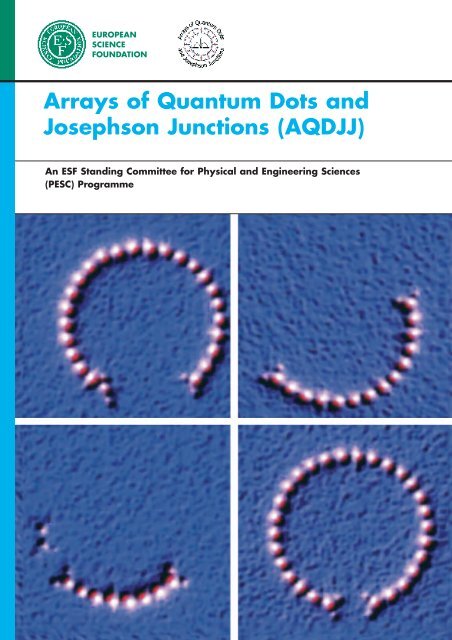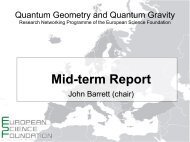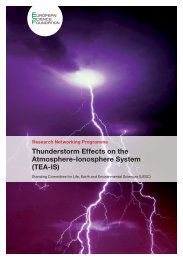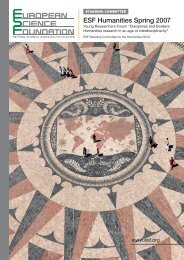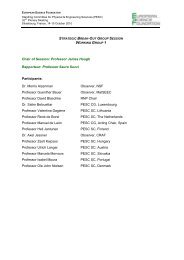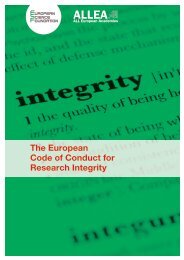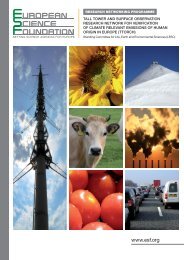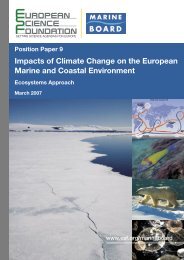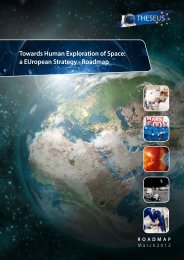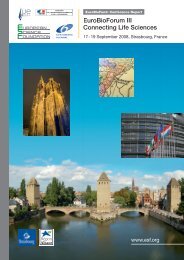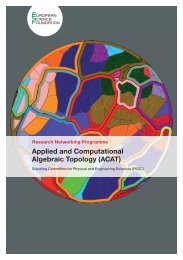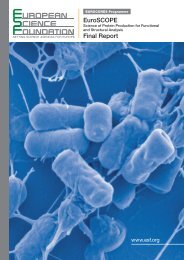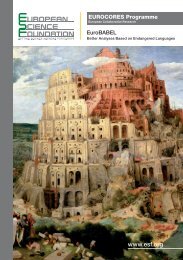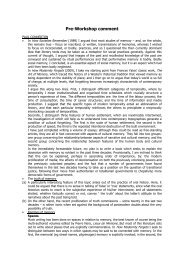Arrays of Quantum Dots and Josephson Junctions (AQDJJ)
Arrays of Quantum Dots and Josephson Junctions (AQDJJ)
Arrays of Quantum Dots and Josephson Junctions (AQDJJ)
Create successful ePaper yourself
Turn your PDF publications into a flip-book with our unique Google optimized e-Paper software.
EUROPEAN<br />
SCIENCE<br />
FOUNDATION<br />
<strong>Arrays</strong> <strong>of</strong> <strong>Quantum</strong> <strong>Dots</strong> <strong>and</strong><br />
<strong>Josephson</strong> <strong>Junctions</strong> (<strong>AQDJJ</strong>)<br />
An ESF St<strong>and</strong>ing Committee for Physical <strong>and</strong> Engineering Sciences<br />
(PESC) Programme
The physics <strong>and</strong> the properties <strong>of</strong> very small objects<br />
(for example, nanoparticles, <strong>Quantum</strong> <strong>Dots</strong>, <strong>Josephson</strong><br />
<strong>Junctions</strong>) are among the main emerging issues<br />
<strong>of</strong> research in condensed matter physics.<br />
<strong>Arrays</strong> <strong>of</strong> these systems <strong>and</strong> their hybrid structures<br />
may not only display novel fundamental physics<br />
but also serve as a basis for future technologies.<br />
This network has been established to bring together<br />
leading theoretical <strong>and</strong> experimental researchers<br />
in Europe with the view to promote collaboration,<br />
further existing knowledge <strong>and</strong> to continue<br />
investigation <strong>of</strong> these novel areas <strong>of</strong> research.<br />
The running period <strong>of</strong> the ESF scientific programme<br />
<strong>AQDJJ</strong> is for five years from June 2004 until June 2009.<br />
Cover:<br />
Discrete rotobreathers<br />
© A Ustinov, Germany
ARRAYS OF QUANTUM DOTS AND JOSEPHSON JUNCTIONS (<strong>AQDJJ</strong>)<br />
3<br />
Introduction<br />
What are <strong>Quantum</strong> <strong>Dots</strong>?<br />
The term <strong>Quantum</strong> Dot encompasses a wide variety<br />
<strong>of</strong> zero dimensional systems. If we consider that a<br />
line is a 1-dimensional object, then zero dimensional<br />
simply means a point or dot. <strong>Arrays</strong> <strong>of</strong> <strong>Quantum</strong> <strong>Dots</strong><br />
are simply groups <strong>of</strong> these small objects joined<br />
together <strong>and</strong> considered as one system.<br />
Figure 4 © E Weig, Germany<br />
Figure 4 depicts a freely suspended, tuneable (via<br />
applying different gate voltages), two quantum dot<br />
system. A two-qubit system (together with singlequbit<br />
operations) is sufficient to implement arbitrary<br />
algorithms on a quantum computer.<br />
Figure 2 © E Weig, Germany<br />
Figure 2 is a schematic drawing <strong>of</strong> a <strong>Quantum</strong> Dot,<br />
in which an electron tunnels from the source (on the<br />
left) to the isl<strong>and</strong> (in the middle), <strong>and</strong> then from the<br />
isl<strong>and</strong> to the drain (on the right), emitting a phonon<br />
in the process due to interaction with the lattice. Once<br />
on the isl<strong>and</strong>, the electron can be manipulated so that<br />
it behaves as a qubit (a quantum bit), <strong>and</strong> therefore<br />
this set-up could be used in quantum information<br />
processing.<br />
Figure 5<br />
© R Wördenweber, Germany<br />
A related concept is that <strong>of</strong> antidots (or holes),<br />
depicted in Figure 5. If there is a vacancy (hole) at<br />
each site, then electrons are free to move across this<br />
array <strong>of</strong> antidots. In this case, for example, we could<br />
consider the additional electron spin as the model for<br />
our qubit.<br />
Figure 3 © M S Garelli, UK<br />
Figure 3 depicts two Buckyballs. A Buckyball is a<br />
C-60 fullerene molecule, containing an encased<br />
atom. The encased atom behaves as a qubit. Therefore<br />
this is an array <strong>of</strong> two quantum dots. Such<br />
arrays are easily scalable to any number <strong>of</strong> Buckyballs.<br />
In systems consisting <strong>of</strong> arrays <strong>of</strong> small nanoscopic<br />
magnetic disks or quantum dots many new phenomena<br />
arise associated with magnetic pattern formation<br />
<strong>and</strong> fractal structures in particular. The fractal features<br />
may arise not only in the distribution <strong>of</strong> magnetic<br />
moments but also in their energy spectrum. The<br />
magnetization <strong>and</strong> the susceptibility <strong>of</strong> the system<br />
also display fractal characteristics. The signature<br />
<strong>of</strong> these fractal structures can be experimentally<br />
detected by various methods, in particular, by Kerr<br />
rotations. The system <strong>of</strong> nano-disks may be used to<br />
form memory cells <strong>and</strong> may form a three dimensional<br />
s<strong>and</strong>wich array, as presented in Figure 6 (following<br />
page).
4 ARRAYS OF QUANTUM DOTS AND JOSEPHSON JUNCTIONS (<strong>AQDJJ</strong>)<br />
What are <strong>Josephson</strong> <strong>Junctions</strong>?<br />
A <strong>Josephson</strong> junction consists <strong>of</strong> a very thin insulating<br />
layer (e.g. AlO x ) s<strong>and</strong>wiched between two superconducting<br />
materials (e.g. Nb), as shown in the diagram.<br />
A spontaneous current is created in the insulating<br />
contact between the two superconductors due to the<br />
overlapping <strong>of</strong> the two superconductors’ wavefunctions.<br />
This overlap allows a Cooper pair <strong>of</strong> two electrons<br />
to penetrate from one superconductor to another.<br />
Nb AlO x<br />
Nb<br />
Figure 6 © K. Kürten, Austria & F V Kusmartsev, UK<br />
Superconducting quantum dots exhibit different properties<br />
depending on their geometry. Different geometries<br />
are shown in Figure 7 (circular, asymmetric<br />
circular, square <strong>and</strong> triangular).<br />
Figure 8 © A Ustinov, Germany<br />
Exploring <strong>and</strong> underst<strong>and</strong>ing the structure <strong>and</strong><br />
dynamics <strong>of</strong> low energy excitations in complex<br />
<strong>Josephson</strong> systems such as <strong>Josephson</strong> ladders, long<br />
<strong>Josephson</strong> junctions <strong>and</strong> others in different geometries<br />
<strong>and</strong> types <strong>of</strong> background will be crucial to development<br />
<strong>of</strong> new technologies.<br />
Figures 9 <strong>and</strong> 10 show some <strong>of</strong> the systems we are<br />
interested in studying.<br />
linear ladder<br />
Figure 7 © M Morelle, V Moshchalkov, Belgium et al<br />
It is not possible to engineer arrays <strong>of</strong> nanoparticles<br />
<strong>and</strong> quantum dots due to their sub microscopic size.<br />
Instead, these structures are “grown”. Continued<br />
intensive investigation <strong>of</strong> their growth <strong>and</strong> properties<br />
<strong>of</strong> these nanostructures is necessary for application to<br />
new technologies.<br />
2D array<br />
Figure 9 © A Ustinov, S Flach, Germany et al<br />
annular ladder
ARRAYS OF QUANTUM DOTS AND JOSEPHSON JUNCTIONS (<strong>AQDJJ</strong>)<br />
5<br />
Figure 12 © P Martinoli, Switzerl<strong>and</strong><br />
Similar behaviour arises in superconducting networks<br />
<strong>of</strong> metallic wires (depicted in Figure 12).<br />
The transition from classical to quantum tunnelling,<br />
<strong>and</strong> tunnelling phenomena in general (as depicted in<br />
Figure 13), is an area not yet fully understood <strong>and</strong><br />
needs further development.<br />
Tunnel barrier<br />
Figure 10: A stack <strong>of</strong> <strong>Josephson</strong> <strong>Junctions</strong>.<br />
© N Pedersen, Denmark, G Filatrella, Italy<br />
ϕ 1<br />
ϕ 2<br />
The behaviour <strong>of</strong> <strong>Josephson</strong> vortices (which occur in<br />
<strong>Josephson</strong> junctions) <strong>and</strong> other physical properties<br />
depends on the symmetry <strong>of</strong> the elementary cell in the<br />
<strong>Josephson</strong> junction array. Examples <strong>of</strong> different cell<br />
symmetries are shown in Figure 11: striped, zigzag<br />
<strong>and</strong> honeycomb dice lattice (above) <strong>and</strong> triangular<br />
array (below).<br />
FM<br />
V<br />
width d<br />
I<br />
A<br />
FM<br />
Figure 13 © A Barone, M Cirillo, Italy et al<br />
Figure 11 © P Martinoli, Switzerl<strong>and</strong>
6 ARRAYS OF QUANTUM DOTS AND JOSEPHSON JUNCTIONS (<strong>AQDJJ</strong>)<br />
Applications<br />
<strong>Arrays</strong> <strong>of</strong> nanoparticles in organic matrices <strong>and</strong> quantum<br />
dots, as well as arrays <strong>of</strong> <strong>Josephson</strong> <strong>Junctions</strong><br />
may have numerous practical <strong>and</strong> industrial applications<br />
as they are highly efficient <strong>and</strong> simple to use.<br />
Applications could be in quantum dot lasers,<br />
Magnetic R<strong>and</strong>om Access Memory (MRAM, see<br />
Figure 14), Terahertz radiation sources <strong>and</strong> receivers /<br />
antennae, quantum computers (see Figure 15),<br />
biotechnology <strong>and</strong> nanomagnetism.<br />
THz Radiation<br />
THz radiation is potentially a very important area <strong>of</strong><br />
research. This frequency gap is currently not being<br />
used, <strong>and</strong> in fact corresponds with the frequency <strong>of</strong><br />
signals in the human brain. It may be that developing<br />
THz technology will help us to underst<strong>and</strong> how the<br />
brain works. THz radiation is a lot less damaging than<br />
other rays, for example X-rays, yet it still has the ability<br />
to penetrate most materials. Possible usage could<br />
be to permanently scan things (for example in<br />
airports) without the danger <strong>of</strong> harmful radiation.<br />
resonator<br />
SL<br />
THz<br />
Figure 14: MRAM, made <strong>of</strong> three dimensional arrays<br />
<strong>of</strong> magnetic nanodisks.<br />
© K. Kürten, Austria et al<br />
n + -layer<br />
Ohmic contacts<br />
superlattice<br />
substrate<br />
Figure 15: Building a working quantum computer<br />
consisting <strong>of</strong> a s<strong>and</strong>wich <strong>of</strong> <strong>Josephson</strong> junctions or<br />
an array <strong>of</strong> <strong>Josephson</strong> junctions <strong>and</strong> a microwave<br />
photonic crystal. These devices could be used as<br />
elementary building blocks for a quantum<br />
telecommunication network.<br />
© F V Kusmartsev, UK et al<br />
Figure 16: Development <strong>of</strong> new approaches for<br />
a THz generator with a semiconductor superlattice<br />
as the active element.<br />
© K N Alekseev et al, Finl<strong>and</strong>
ARRAYS OF QUANTUM DOTS AND JOSEPHSON JUNCTIONS (<strong>AQDJJ</strong>)<br />
7<br />
Magnetic particles<br />
A magnetic nanocomposite is a natural <strong>and</strong>/or artificial<br />
mixture <strong>of</strong> magnetic particles <strong>of</strong> nanometre sizes<br />
embedded into non-magnetic, insulating, semiconducting<br />
or metallic environments. Assemblies <strong>of</strong><br />
small magnetic particles are formed by nature in<br />
many biological <strong>and</strong> geological systems (for example<br />
blood, soils <strong>and</strong> rocks). They can also be prepared<br />
artificially. Their magnetic characteristics are greatly<br />
enhanced due to finite size effects. This giant amplification<br />
<strong>of</strong> the sensitivity <strong>of</strong> such materials to external<br />
electromagnetic radiations means that they may be<br />
used in many unique applications. Magnetic <strong>and</strong> electrical<br />
properties (including electrical resistivity) <strong>and</strong><br />
reflectivity may be changed by several orders depending<br />
on the particle sizes, separation <strong>and</strong> composition.<br />
These properties are applicable in magnetoresistive<br />
sensors <strong>and</strong> read heads, magnetic recording media,<br />
write heads <strong>and</strong> shielding <strong>and</strong> screening materials for<br />
heads <strong>and</strong> radars. Complex dynamical behaviour such<br />
as magnetization reversal (which has been recently<br />
observed when subject to intense short pulses <strong>of</strong><br />
magnetic field) could revolutionise the technology <strong>of</strong><br />
fast data flow, reading <strong>and</strong> writing information on<br />
hard disks <strong>and</strong> eventually be implemented for data<br />
storage systems <strong>of</strong> very high capacity. The analysis<br />
<strong>of</strong> such dynamical processes is an important new area<br />
<strong>of</strong> research.<br />
Activities<br />
Workshops<br />
One workshop will take place each year for approximately<br />
30-50 participants in different European countries,<br />
i.e. Croatia, Italy, Sweden, UK <strong>and</strong> others.<br />
Exchange visits<br />
Two types <strong>of</strong> grants for exchange visits are available:<br />
• Short visit grants <strong>of</strong> up to 15 days<br />
• Exchange grants, from 15 days to three or six<br />
months<br />
Website<br />
A homepage is maintained on the ESF website, in<br />
addition to the programme’s own homepage which<br />
can be found at:<br />
http://www-staff.lboro.ac.uk/~phrtg/aqdjj<br />
Funding<br />
ESF scientific programmes are principally financed<br />
by the Foundation’s Member Organisations on an à<br />
la carte basis. <strong>AQDJJ</strong> is supported by:<br />
Fonds zur Förderung der wissenschaftlichen<br />
Forschung, Austria; Fonds voor Wetenschappelijk<br />
Onderzoek – Vla<strong>and</strong>eren, Belgium; Akademie věd<br />
České republiky, Czech Republic, Grantová agentura<br />
České republiky, Czech Republic; Statens Naturvidenskabelige<br />
Forskningsråd, Denmark; Suomen<br />
Akatemia/Finl<strong>and</strong>s Akademi, Finl<strong>and</strong>; Deutsche<br />
Forschungsgemeinschaft, Germany; Consiglio<br />
Nazionale delle Ricerche, Italy; Slovenská Akadémia<br />
Vied, Slovak Republic; Oficina de Ciencia y<br />
Tecnologia, Spain; Institut Catala de Nanotecnologies,<br />
Instituto de Magnetismo Aplicado UCM-<br />
RENFE-CSIC, Spain; Vetenskapsrådet, Sweden;<br />
Schweizerischer Nationalfonds zur Förderung der<br />
wissenschaftlichen Forschung/Fonds national suisse<br />
de la recherche scientifique, Switzerl<strong>and</strong>; Engineering<br />
<strong>and</strong> Physical Sciences Research Council, United<br />
Kingdom.<br />
Conference collaboration<br />
Occasionally this network will collaborate with an<br />
existing conference to allow for a wider scope <strong>of</strong><br />
researchers to attend. The first one was a joint Conference<br />
with Japanese Physical Society, which took<br />
place in September 2005 in Crete.<br />
Summer schools<br />
Each year a summer school will be arranged with the<br />
first one being in June 2005 in Kiten, Bulgaria.
EUROPEAN<br />
SCIENCE<br />
FOUNDATION<br />
European Science Foundation<br />
1 quai Lezay-Marnésia, BP 90015<br />
67080 Strasbourg cedex, France<br />
Tel: +33 (0)3 88 76 71 00<br />
Fax: +33 (0)3 88 37 05 32<br />
www.esf.org<br />
<strong>AQDJJ</strong> Steering Committee<br />
Pr<strong>of</strong>essor Feodor V. Kusmartsev (Chair)<br />
Department <strong>of</strong> Physics<br />
Loughborough University<br />
Leicestershire LE11 3TU<br />
United Kingdom<br />
Tel: +44 1509 22 3316<br />
Fax: +44 1509 22 3986<br />
E-mail: F.Kusmartsev@lboro.ac.uk<br />
Dr. Jan Koláček<br />
Institute <strong>of</strong> Physics ASCR<br />
Cukrovarnicka 10<br />
162 53 Prague 6<br />
Czech Republic<br />
Tel: +420 220 318 505<br />
Fax: +420 233 343 184<br />
E-mail: kolacek@fzu.cz<br />
Pr<strong>of</strong>essor Petter Minnhagen (Observer)<br />
NORDITA<br />
Blegdamsvej 17<br />
2100 Copenhagen<br />
Denmark<br />
Tel: +45 353 25222<br />
Fax: +45 353 89157<br />
E-mail: minnhagen@nordita.dk<br />
Pr<strong>of</strong>essor Piero Martinoli<br />
(Co-chair)<br />
Institut de Physique<br />
Université de Neuchâtel<br />
Rue A.-L. Breguet 1<br />
2000 Neuchâtel<br />
Switzerl<strong>and</strong><br />
Tel: +41 32 718 2907<br />
Fax: +41 32 718 2901<br />
E-mail: piero.martinoli@unine.ch<br />
Pr<strong>of</strong>essor Antonio Barone<br />
Department <strong>of</strong> Physical Sciences<br />
University <strong>of</strong> Naples “Federico II”<br />
Piazzale Tecchio, 80<br />
80125 Naples<br />
Italy<br />
Tel: +39 081 768 2416<br />
Fax: +39 081 239 1821<br />
E-mail: barone@na.infn.it<br />
Dr. Stefan Benacka<br />
Slovak Academy <strong>of</strong> Sciences<br />
Institute <strong>of</strong> Electrical Engineering<br />
Department <strong>of</strong> Cryoelectronics<br />
Dúbravská cesta 9<br />
84104 Bratislava<br />
Slovak Republic<br />
Tel: +421 2 5477 5826<br />
Fax: +421 2 5477 5816<br />
E-mail: elekbena@savba.sk<br />
Pr<strong>of</strong>essor Per Delsing<br />
Microtechnology <strong>and</strong> Nanoscience<br />
Chalmers University <strong>of</strong> Technology<br />
412 96 Göteborg<br />
Sweden<br />
Tel: +46 31 772 3317<br />
Fax: +46 31 772 3442<br />
E-mail: per.delsing@mc2.chalmers.se<br />
Pr<strong>of</strong>essor Niels Falsig Pedersen<br />
Oersted-DTU<br />
Technical University <strong>of</strong> Denmark<br />
Electrical Power Engineering<br />
Building 325<br />
2800 Lyngby<br />
Denmark<br />
Tel: +45 45 88 16 33<br />
Fax: +45 45 88 61 11<br />
E-mail: nfp@oersted.dtu.dk<br />
Pr<strong>of</strong>essor Victor Moshchalkov<br />
INPAC – Institute for Nanoscale Physics<br />
<strong>and</strong> Chemistry<br />
Katholieke Universiteit Leuven<br />
Celestijnenlaan 200 D<br />
3001 Leuven<br />
Belgium<br />
Tel: +32 16 32 76 18<br />
Fax: +32 16 32 79 83<br />
E-mail: victor.moshchalkov@fys.kuleuven.be<br />
Pr<strong>of</strong>essor Mikko Paalanen<br />
Helsinki University <strong>of</strong> Technology<br />
P.O. Box 2200<br />
02015 Helsinki<br />
Finl<strong>and</strong><br />
Tel: +358 9 451 2957<br />
Fax: +358 9 451 2969<br />
E-mail: paalanen@neuro.hut.fi<br />
Pr<strong>of</strong>essor Alvaro Sanchez<br />
Departament de Fisica<br />
Universitat Autonoma de Barcelona<br />
Bellaterra<br />
08193 Barcelona<br />
Spain<br />
Tel: +34 93 5811132<br />
Fax: +34 93 5811350<br />
E-mail: alvar.sanchez@uab.es<br />
Pr<strong>of</strong>essor Alexey Ustinov<br />
Physikalisches Institut III<br />
Universität Erlangen-Nürnberg<br />
Erwin-Rommel Str.1<br />
91058 Erlangen<br />
Germany<br />
Tel: +49 9131 8 527 268<br />
Fax: +49 9131 1 5249<br />
E-mail: ustinov@physik.uni-erlangen.de<br />
Pr<strong>of</strong>essor Harald W. Weber<br />
Atominstitut der Österreichischen<br />
Universitäten<br />
Stadionallee 2<br />
1020 Wien<br />
Austria<br />
Tel: +43 1 58801 14140<br />
Fax: +43 1 58801 14199<br />
E-mail: weber@ati.ac.at<br />
Dr. Richard Giles<br />
(Website Coordinator)<br />
Department <strong>of</strong> Computer Science<br />
Loughborough University<br />
Leicestershire LE11 3TU<br />
United Kingdom<br />
Tel: +44 1 509 22 3316<br />
Fax: +44 1 509 22 3986<br />
E-mail: R.T.Giles@lboro.ac.uk<br />
Ms. Debbie Dalton<br />
(Programme Coordinator)<br />
Department <strong>of</strong> Physics<br />
Loughborough University<br />
Leicestershire LE11 3TU<br />
Tel: +44 1509 223345<br />
Fax: +44 1509 223986<br />
E-mail: D.C.Dalton@lboro.ac.uk<br />
ESF Liaison<br />
Dr. Patrick Bressler<br />
Science<br />
Ms. Catherine Werner<br />
Administration<br />
Physical <strong>and</strong> Engineering Sciences Unit<br />
(PESC)<br />
European Science Foundation<br />
1 quai Lezay-Marnésia<br />
BP 90015<br />
67080 Strasbourg cedex – France<br />
Tel: +33 (0)3 88 76 71 28<br />
Fax: +33 (0)3 88 37 05 32<br />
E-mail: cwerner@esf.org<br />
For the latest information<br />
on this programme consult<br />
the <strong>AQDJJ</strong> home page:<br />
www.esf.org/aqdjj<br />
October 2005 – Print run: 1500


